Matador Network's Blog, page 1091
May 22, 2019
Best hikes in North Carolina

North Carolina is pure heaven in the summer. The breezes along the Outer Banks make the humid beach days feel like a tropical paradise. The cities are alive with summer festivals. And the mountains in the west are warm enough to hike — and usually dry enough to do it comfortably. Of course, in spots like Great Smoky Mountain National Park and much of Asheville, you’ll find tens of thousands of other people who are in on North Carolina’s beauty too. In other areas, however, you can still find hikes where you’ll be alone with nature. Here are seven of the best hikes in North Carolina you shouldn’t have to share with too many other people.
1. The Richland Balsam Overlook

Photo: Courtesy of Jackson County TDA
One would think going to the highest point along the Blue Ridge Parkway would be a grueling, daylong trek up rock boulders and mud. However, it’s actually a pleasant, 1.5-mile jaunt through a spruce-fir forest, with wildflowers that make it the best-smelling trail along the Parkway. The hike, which takes you up 700 vertical feet to 6,053 feet above sea level, is at milepost 431.4 of the Parkway and a calming roadside respite.
Getting there: Going towards Asheville on the Blue Ridge Parkway, head to milepost 431 and turn left into the Haywood-Jackson overlook parking lot. The trail starts in the left corner of the lot.
2. High Falls Trail
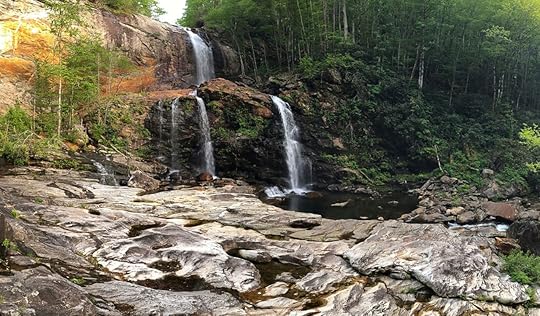
Photo: Nick Breedlove
There’s no shortage of spectacular waterfall trails in North Carolina, but this one is rarely full of people and nearly all downhill. On the way there, anyway. The trip starts at either an upper or lower trailhead, the former off Pine Creek Road in Jackson County, the latter off unpaved Shoal Creek Road near US-64. The upper trail is much easier, about a mile to the falls along a graded road with a good number of steps. The lower trail is a little tougher, about two miles across Shoal Creek, around a ridge, and past Rough Run falls. The two-falls-for-the-price-of-one adventure ends at High Falls, a 100-foot drop fed by the Tuskegee River with a two-section free-fall off a cliff. Whichever route you take, you’ll need to work through some slippery boulders to get to the swimming hole at the base.
Getting there: For the upper trailhead, start in Cashiers and take NC 107 north to Pine Creek Road (SR 1163). About two miles down, park on the right at the Pines Recreation Area. For the lower trailhead, take NC 107 north only eight miles and turn left onto Shoal Creek Road.
3. Waterrock Knob Trail

Photo: Courtesy of Jackson County TDA
The most bang for your mileage buck this summer is the Waterrock Knob trail, a 1.2-mile round trip to the 6,292-foot summit. The 412-feet of elevation gain in the brief three-fifths of a mile to the top might have you stopping to catch your breath a time or two. Which is totally fine since this trail is full of mesmerizing vistas out over western North Carolina. The best views are reserved for the top, though, where the panorama stretches for nearly 50 miles on clear days.
Getting there: From Sylva, take US-23 North/US-73 East 11 miles to the Blue Ridge Parkway entrance at Balsam Gap. Then head south towards Cherokee to Waterrock Knob at milepost 451.2.
4. Owl’s Roost Trail

Photo: Robert Seth
Despite this trail near Lake Brandt being named the best urban mountain-biking trail in America by Bicycle Magazine a few years back, hikers still have the right-of-way along its steep hills and tricky descents. The trailhead begins near the end of Bur-Mil park and can run anywhere from four to 5.6 miles, depending on how many of the other lakeside trails you explore. It’s a calming route to walk by the water and challenge yourself with some vertical terrain, and some of the paths are even paved for a pretty easy technical adventure.
Getting there: From downtown Greensboro, take US-220 (Battleground Ave.) north for 5.7 miles. Turn right onto Owls Roost Road, then left onto Bur-Mil Club Road. Head all the way to the Wildlife Education Center at the end of the road, and begin your journey from there.
5. Whiteside Mountain Trail

Photo: Courtesy of Jackson County TDA
Few outside of the climbing community probably know the highest vertical cliffs in the eastern United States are at Whiteside Mountain. The cliffs measure about 1,800 feet and draw climbers from all over the world during season. Whiteside’s peak stands at 4,930 feet, and the two-mile trail along the cliffs still takes most people about 90 minutes to complete. The path is filled with purple wildflowers and panoramic views, with peregrine falcons swooping over the valley in the distance. You’ll also find yourself walking through a forest of Canadian hemlock, Fraser magnolia, and yellow and black birch trees, with Carolina rhododendrons filling in between them.
Getting there: Whiteside Mountain sits south of US-64, between Highlands and Cashiers. Look for signs for SR-1600 Whiteside Mountain Road. Head down the road then follow the signs to Forest Service Parking and Trailhead.
6. Pinnacle Park Trail

Photo: Nick Breedlove
If you’re looking to put a few more miles on your shoes, try this seven-mile trek through Pinnacle Park. It’ll take you about half a day, going 3,000 feet up the side of the mountain, past small waterfalls, streams, and peeks at the mountains in the distance. The out-and-back trail sits in a 1,000-acre town park in Sylva, running up an old logging road, through some grass, and on to a challenging rocky section. It’s not exactly an expert technical trail but will involve a little bit of skill traversing the boulders. Once at the top you’ll find sweeping views of Sylva and Scotts Creek Valley.
Getting there: Pinnacle Park is in the town of Silva, in the Plott Balsam Mountains about 50 minutes west of Asheville. Once in town, find your way to Fraser Creek Road and take it two miles to park’s gravel parking lot.
7. Silver Run Falls
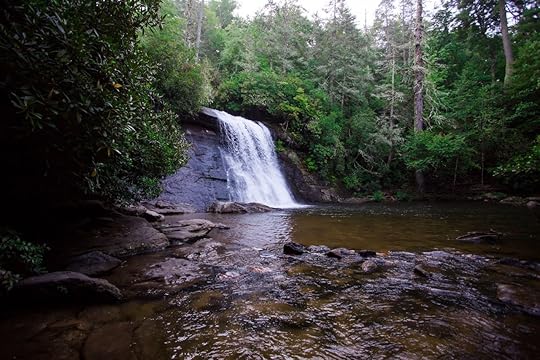
Photo: Courtesy of Jackson County TDA
This will, without a doubt, be the easiest waterfall hike you’ll take in North Carolina. At a small pullout off NC-107, you’ll find a short trailhead that dips down next to an American holly tree. A brief stroll to a footbridge over the Whitewater River brings you to the base of a 40-foot waterfall. This may not sound overly impressive, but for a small waterfall, it’s one of the most photogenic in America, with free-falling water and vertical slides dropping into an expansive pool. Silver Run Falls is a great place to take a short dip or a slew of vacation selfies — and looks a lot further away than 500 feet from a major highway.
Getting there: Turn onto NC-107 off US-64 and go about five miles to the turnout. 

More like this: How to use Asheville as your base for Great Smoky Mountains National Park
The post 7 North Carolina summer hikes most of the world hasn’t discovered appeared first on Matador Network.

Oregon’s Three Capes Scenic Loop

The Oregon Coast has been known as the People’s Coast for over 50 years, ever since the state passed a law granting free and open access to all 363 miles of its majestic beachline. Oregon’s rugged shores are a Pacific Northwest treasure that deserve to be explored in their entirety. Without that kind of time, though, the Three Capes Scenic Loop is an excellent alternative. The 40-mile excursion is an easy day trip from Portland and showcases everything that’s best about the Oregon Coast — from towering sea stacks loaded with migrating birds to secluded, sandy beaches to headland forests of spruce and pine that are ideal whale-watching destinations. It just may become your favorite summer road trip. Here’s what you need to know.
Why Three Capes?

Photo: Marilyn D. Lambertz/Shutterstock
The stars of Oregon’s Three Capes Scenic Loop are Cape Kiwanda, Cape Lookout, and Cape Meares, enormous rock outcroppings that stretch into the Pacific Ocean. Each of these capes has its own distinct personality, so it’s not enough to just park it at one. You should take the whole loop. Pack your hiking shoes, because you’ll want them for treks throughout the forest and along the headlands. Don’t forget your beach towel and sandals; you’ll need them too.
Get an early start, so you’ll have time for hiking, especially at Cape Lookout. From Portland, drive west on Highway 26 through the Tillamook Forest. When you get to the township of Tillamook, you’ll have to choose how to approach this loop: from north to south or south to north. There’s no wrong answer. Just keep your eyes peeled for the green sign on the road pointing you toward the Three Cape Scenic Loop. For our purposes, we’ll start by heading south to Pacific City, home to Cape Kiwanda, and take the loop northwards from there.
Part One: Cape Kiwanda and Pacific City
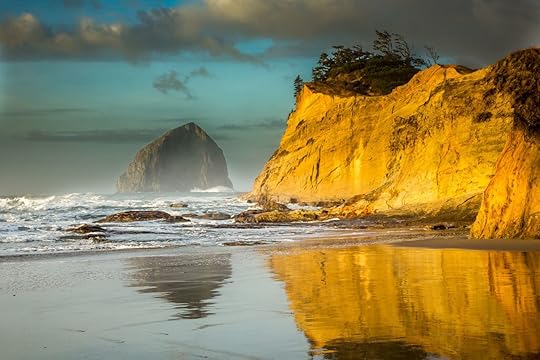
Photo: Bob Pool/Shutterstock
Cape Kiwanda gracefully bows across the north edge of the long, sandy beach at Pacific City. At its feet, crystalline tides rush in and out, carving smooth chasms through the basalt rock formations. In the distance rises the tip of Haystack Rock — not to be confused with the Haystack Rock at Cannon Beach, made famous in the film The Goonies. This massive sea stack peaks at 327 feet tall.
When showing up at Cape Kiwanda, it’s hard to know what to focus on: the cape itself, Haystack Rock, or the 240-foot massive dune towering in the sky and the intrepid souls scurrying up its sandy slope. If you decide to join them in a trek to the top, you’ll be rewarded with panoramic views in all directions.

Photo: RS Smith Photography/Shutterstock
If you do ascend the dunes, you’ll notice warning signs, a fence row, and oodles of curious folk disobeying the aforementioned warning signs and climbing through the fence. Please don’t. While the stunning views are alluring, Oregon State Parks urges visitors to stay within fenced areas as the sandstone cliff at Cape Kiwanda edges can splinter off.
Oregon’s coast range is the true meaning of sublime: beautiful with a huge dash of danger. When visiting, keep in mind that these sandstone cliffs are unstable and have been known to give way. In fact, to the west and north, you’ll see those sandstone cliffs and bowls being smashed by the turbulent Pacific, their chasms filled with boulders and logs.
To the south, on the other hand, you’ll behold Pacific City, a hub bustling with hotels and restaurants. Head into the beach town to grab a pint of the city’s homebrew, Pelican Brewing, and a meal, because you’ll need it for the adventure ahead. While you’re waiting, keep your ears perked; if you’re lucky, you’ll hear the blaring horn of a dory boat as it rushes ashore with its haul of fresh catch.
Part One detour: the Nestucca Spit
View this post on InstagramA post shared by Theres Iwanchuk (@theresiwanchuk) on Apr 27, 2019 at 11:10pm PDT
After you’ve climbed the sand dune at Cape Kiwanda and soaked up views of Haystack Rock and Pacific City, consider taking a detour to the south end of Pacific City to visit Bob Straub State Park. Here, you can escape the crowd in Pacific City and hike through coastal marshes of salal shrub and atop grassy dunes along the Nestucca spit, an example of the dynamic range of ecosystems on the Oregon Coast.
While there are many great spots for beachcombing on this trip, the Nestucca spit is especially perfect because it’s lightly trafficked and loaded with driftwood. As you ramble down the spit, a clear view of Haystack Rock and Cape Kiwanda will be just over your shoulder. If you have an all-wheel-drive vehicle, then speed along this remote stretch of Oregon beach to the very end, where solitude awaits you.
Part Two: Cape Lookout

Photo: Tada Images/Shutterstock
When you’re ready, travel north to Cape Lookout State Park, a popular area for camping, yurting, and picnicking. One of the unique features of Cape Lookout is that you can hike the headland by taking The Cape Lookout Trail, a smooth out-and-back of about five miles. It snakes through dense pine forest but never strays far from ocean views.
At the end of the trail, you will arrive at the head of the cape, where you will find a bench and what feels like the edge of the Earth. At that moment, you’ll understand why it’s called Cape Lookout. Miles from shore and hundreds of feet in the air, it’s great for gazing onto an uninterrupted view of the Pacific before hiking back to the trailhead. If you’re visiting during spring or late fall, watch for migrating whales.
Part Three: Cape Meares
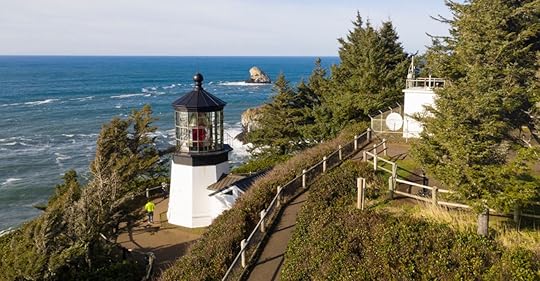
Photo: Christopher Boswell/Shutterstock
Cape Meares is the northernmost stop in this loop. Cape Meares, a national wildlife refuge, has several claims to fame. Among them are the Octopus Tree, the largest Sitka spruce tree in the state of Oregon, and the 1890s Cape Meares Lighthouse, which hosts free tours from May to September.
Two other notable features of this cape are Pillar Rock and Pyramid Rock. Like all the sea stacks on the Oregon Coast, these rocks are part of the Oregon Islands Refuge, a project to preserve and protect wildlife. US Fish and Wildlife Services reports that these two sea stacks harbor an upwards of 20,000 nesting seabirds.
If you’re looking for one last hike, Cape Meares has the seldom-traveled Cape Meares Beach Trail. At 1.8 miles round trip, the moderately traveled trail will immerse you in old-growth forest; you’ll be surrounded by lush, leafy ferns as you make your way along switchbacks. Eventually, you’ll arrive at a marshy lowland of beach grass and wind-gnarled spruce trees.
To access this secluded, rocky beach, follow the trail down the embankment. You’ll find a metal rope tied to a tree that you can use to repel down the embankment, or you can continue on for a more gentle way onto the beach. If it’s been raining, please keep an eye out for Banana Slugs, as the marshy lowland is their home and they often make their way onto the trail.
The last stop: Oceanside
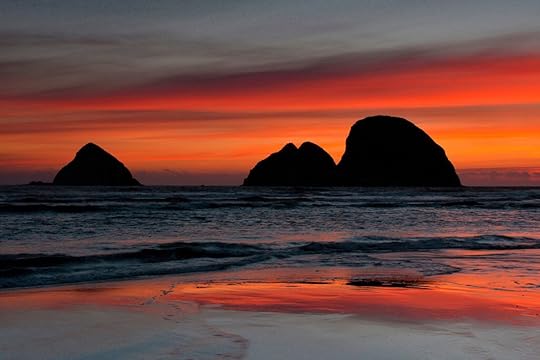
Photo: Danita Delmont/Shutterstock
After you’ve exhausted yourself, head down to Oceanside, just a few short miles south from Cape Meares. With its hotels, beach houses, restaurants, cafes, and dynamic beach, Oceanside is the perfect last stop. Here, you can relax and enjoy the sunset — and maybe wind down by doing some rockhounding, as this is a popular spot for agate hunting.
The logic in starting at Pacific City and concluding in Oceanside becomes apparent when you spread out on a blanket and catch the sunset on the Three Arches, one of the wonders of the Oregon Coast. But, if you take the reverse route, you’ll be just as happy to behold the sun sinking next to Haystack Rock and Cape Kiwanda at Pacific City. It’s win-win either way you go, so start exploring. 

More like this: This is the most beautiful road trip through the Pacific Northwest
The post Oregon’s Three Capes Scenic Loop is the perfect day trip from Portland appeared first on Matador Network.

McDonald’s for bees

McDonald’s is broadening its target demographic in some pretty creative ways these days. Pretty much every human has been to a McDonald’s at least once, but there’s one untapped market just waiting to be exploited for profit: bees. The fast-food chain just unveiled a mini restaurant designed for bees, complete with drive-thru windows, tables, and, of course, the golden arches. This “smallest McDonald’s in the world,” created for bees, is actually a functioning beehive.

Photo: NORDDDB/Youtube
The McHive was built in honor of McDonald’s new campaign to promote the well-being and preservation of bees. Several of the chain’s restaurants in Sweden already have beehives on their roofs, and the McHive is only the latest step in the broader effort.
NORD DDB, the creative agency that oversaw the project, explained, “The initiative started out locally but is now growing. More franchisees around the country are joining the cause and have also started replacing the grass around their restaurants with flowers and plants that are important for the wellbeing of wild bees.”

Photo: NORDDDB/Youtube
The project is an attempt to encourage franchises all around the world, not just in Sweden, to follow suit and take part in McDonald’s creative sustainability efforts.
This video will give you a more detailed idea of the hive’s construction, and what it looks like inside. 
H/T: Designboom

More like this: McDonald’s is offering menu items from other countries. And we tried them all.
The post A look inside the world’s smallest McDonald’s for bees appeared first on Matador Network.

Birds vacuumed during olive harvest

If watching Super Size Me was enough to stop you from eating McDonald’s, once you learn where olives comes from, you’ll probably think twice about ordering that Martini. According to a report from Nature, the machinery used to gather olives in Portugal and Spain often results in unwitting birds being sucked right off their branches and killed. Over two million birds perish each year during the olive harvest.
Vanessa Mata, lead researcher at Portugal’s Research Center in Biodiversity and Genetic Resources, says, “The machinery is perfectly fine if used during the day, as birds are able to see and escape while they are operating… However, during the night they use very strong lights which confuse the birds and lead to their death as they are ‘sucked in’ by the tractor.”
Since olive-harvesting season from October to January overlaps with bird migration patterns, several types of birds are at risk, including warblers, thrushes, wagtails, robins, and finches. The Andalusian Ministry of Environment and Planning is asking for changes to the harvesting process, writing, “It’s a real problem with serious environmental repercussions that transcend the Andalusian and national geographical limits.”
Now, no one is telling you to never eat olives again, but before you order extra olives in that Martini, maybe think twice about where they may be coming from. 
H/T: VICE

More like this: 8 classic bartender debates
The post Millions of birds are vacuumed to death during the olive harvest each year appeared first on Matador Network.

Best ramen in each state

Once upon a time, ramen noodles were considered a food for poor college kids and nothing more. Now, ramen restaurants are a staple of the trendiest neighborhoods in America. And no, it’s not just in Portland and San Francisco. Ramen joints have popped up all over the country, from coast to coast — even in Alaska. And like any other cuisine that inspires an intense passion, everyone has their favorite ramen eatery. To aid you in your search for great ramen on your next cross-country road trip, Reviews.org has compiled this map showing the most popular ramen restaurant in each state.

Photo: Reviews.org
To do so, they used Yelp to gather data on the top three most reviewed ramen restaurants in each state’s most populous cities. The results are pretty interesting, especially for ramen aficionados.
The most reviewed ramen bar in the country is Totto’s Ramen Bar in New York, with over 5,600 reviews. And if you live in LA and haven’t checked out Slurpin’ Ramen Bar, you probably should. The place has over 3,600 reviews — the second highest in the nation — and has managed to maintain an impressive 4.5 rating.
For a full list of the top-rated ramen restaurants, and to see what people are saying, check out Reviews.org’s complete list. 

More like this: 12 instant noodle flavors you can only get shipped from Asia, ranked
The post Each state’s top ramen joint, mapped appeared first on Matador Network.

Shipping container Airbnb scam

Some pretty awful Airbnb experiences have been reported over the years, but this one might just top them all. Imagine showing up in Amsterdam expecting to stay at a clean, quaint home and instead finding an illegally parked shipping container. That’s exactly what happened to this man, who anticipated a tidy house with a private bathroom only to discover that his rental was actually a shipping container.
British tourist Ben Speller described his experience in a Facebook post, saying, “So I booked a last minute Airbnb in Amsterdam. Advertised as a clean home with a private bathroom. This is what we found.” He also included pictures of the shipping container sitting on a sidewalk, and it doesn’t exactly look hospitable.

Photo: Ben Speller/The Spurs Show/Facebook

Photo: Ben Speller/The Spurs Show/Facebook

Photo: Ben Speller/The Spurs Show/Facebook
“We had already driven around three times by taxi,” Speller told Amsterdam news outlet AT5. “We thought, ‘This can’t be it!’ But when we got out it turned out that it was true. We opened the door and looked inside, locked the door and left. Then we took a hotel.”
Probably the right move.
The host and listing have since been removed from Airbnb, and the home-sharing company issued the following statement: “Misrepresented or fraudulent listings have no place on our platform, and our team works hard to constantly strengthen our defenses and stay ahead of bad actors.” 
H/T: Apartment Therapy

More like this: This guy smoked cannabis at every single coffeeshop in Amsterdam so you don’t have to
The post Man booked a home on Airbnb and found an illegally parked shipping container instead appeared first on Matador Network.

Best street art in Berlin

From the Berlin Wall to the world’s first urban art museum, Berlin is a global hub of outdoor art. Since the 1960s, the city has cultivated a rich and diverse street art scene and, as a result, the entire city has become a colorful playground for both local and international urban artists. Visiting the city, you’ll find street art and graffiti practically everywhere you look. Here are some of the best places to discover street art in Berlin.
East Side Gallery

Photo: Semmick Photo/Shutterstock
In August of 1961, the East German authorities built a physical barrier to close off East Germans’ access to Berlin and West Germany. The barrier, erected overnight, was built of barbed wire and cinder blocks. But, as time progressed, the East German government developed a more complex security system — complete with concrete walls that were up to 15 feet high, electric fences, and guard towers. The wall itself became a giant canvas for artists and other frustrated West Berliners to express themselves. While the artistic expressions on the west side of the Wall thrived, the east side remained blank.
When the Berlin Wall fell in November of 1989, artists quickly moved into neighborhoods in the eastern part of the city and began transforming these areas into vibrant artistic hubs — Mitte, Friedrichshain, and Prenzlauer Berg, in particular. Around the same time, a large-scale mural project appeared on the remaining pieces of the Berlin Wall. Artists from around the world were invited to paint murals on the Wall’s empty east side as a celebration of reunification and a means of expressing their hopes for a brighter future. This project became known as the East Side Gallery and remains one of the largest open-air galleries in the world today.
Urban Nation

Photo: URBAN NATION/Facebook
When it opened its doors in 2017, Urban Nation: Museum for Urban Contemporary Art became the only museum in the world dedicated exclusively to urban art. As an international institution, Urban Nation showcases what its name suggests — art, creative projects, and social exchange built around preserving the culture and history of outdoor street art. The museum has already hosted the work of renowned national and international street artists, including JR, Herakut, Fintan Magee, Shepard Fairey, Lora Zombie, and Banksy.
Naturally, the work of the museum extends beyond the gallery’s walls and has incorporated the exterior of the building into the collection, as well as the facades of buildings in the surrounding area. Urban Nation has invited street artists from around the world to adorn the facade of the building with captivating murals that welcome the public into the space. Other artworks appear all along Bülowstrasse, where the museum is located. Some of these walls host meter-high murals, while other surfaces are home to smaller creations that are visible only to the most attentive of observers.
Haus Schwarzenberg

Photo: meunierd/Shutterstock
Inside one of the most interesting courtyards in Berlin, you’ll get a taste of the city’s street art diversity. Right next door to the iconic Café Cinema — a dimly lit and lively cafe where filmmakers, artists, and locals have been meeting for decades – you’ll find the entrance to an arcade which is home to Haus Schwarzenberg. Colorful murals, eye-catching graffiti, and thought-provoking paste-ups line every inch of available wall space in this passageway.
You’ll also find several pieces of sculpture art brought to you by Dead Chickens, the Berlin-art group that founded the Monsterkabinett. If you’re up for visiting a surreal, parallel universe, visit their private museum located here and walk through a curated sensory experience.
The nearby Otto Weidt Museum pays tribute to Otto Weidt, a visually impaired German man who helped rescue Jews during the Nazi period by employing and, subsequently, hiding them in his broom and brush making factory. There’s a mural depicting Otto Weidt himself immediately outside of the entrance to the museum.
Dircksenstrasse

Photo: Radiokafka/Shutterstock
If you walk along the train tracks on Dircksenstrasse from Hackescher Markt until Alexanderplatz, you’ll discover a wide array of street art creations by both unknown and famous artists along a roughly half-mile stretch of wall. Remember when we noted the diversity of the art earlier? Well, the art displayed here covers a wide range of mediums, including paste-ups, poster art, sculptures, sticker art, graffiti, and stencil art. The street art landscape here also changes quickly so you can always expect to find something new.
Urban Spree

Photo: Semmick Photo/Shutterstock
The Urban Spree is a dynamic art space located near Warschauer Strasse that houses a gallery, concert room, and event space. The primary aim of the space is to provide a location for the best of urban culture to be displayed, through exhibitions, a bookshop, concerts, an outdoor gallery, and, of course, a beer garden. The gallery includes a number of urban artists, including Above, Klone, Broken Fingaz Crew, Low Bros, 1UP Crew, Peachbeach, and m-city, among others.
The area surrounding Urban Spree, known locally as the RAW Gelände, is also worth exploring if you’re looking to discover more street art. Until 1994, this area was owned by the Deutsche Bahn railway company and was used as a train repair station. The site has since been transformed into a thriving offbeat space for alternative culture, and everywhere you look you’ll find graffiti, street art, and the characters that create and appreciate both. You’ll also find many of Berlin’s most popular bars and clubs here — though there’s also an indoor skate park, a climbing gym housed in a former WWII bunker, and a popular outdoor pool club if you’re not looking to party. On Sundays, you’ll also find a bustling flea market.
Kino Intimes
View this post on InstagramA post shared by Kino Intimes Berlin (@kino.intimes.berlin) on Mar 21, 2018 at 4:43am PDT
Until recently, the Kino Intimes was one of the few Berlin film houses that had been continuously in operation since the beginning of the 20th century. Located at the corner of Boxhagener Strasse and Niederbarnimstrasse, the cinema is easy to spot because of the eye-catching 1970s neon sign that adorns the facade. The exterior of the building is loaded up with street art creations, mainly paste-ups from both known and unknown artists. And while the intimate neighborhood cinema recently closed its doors, there are ongoing discussions with the building owners and tenants about how to best preserve and reopen this landmark. For now, the site is still a popular street art forum and is certainly worth a visit.
Teufelsberg

Photo: Shanti Hesse/Shutterstock
On the outskirts of Berlin, you’ll find Teufelsberg, which translates from German to mean Devil’s Mountain. The hilltop is made from rubble and is built on the site of a never-finished Nazi military college. During the Cold War, the US set up one of its largest listening stations on the hill. After the fall of the Wall, there were short-lived plans to turn the site into a set of hotels and apartment buildings, but this was eventually abandoned.
In 2016, the current owner opened the doors to curious explorers and, since then, the partly overgrown and treet art-covered station has become a popular destination for a day out in the leafy Grunewald area. The impressive view over the city, coupled with a small, on-site café set up by the local community, means that Teufelsberg is the perfect escape from the bustle of Berlin and offers a unique experience you won’t find in any other European capital. If you’re feeling particularly creative, you can actually take a street art class here to hone your own artistic genius on the walls of the former American listening station.
Art Park Tegel

Photo: URBAN NATION/Facebook
In the Reinickendorf district, not too far from the southernmost edge of Tegeler See, you will find a collection of typical 1970s Plattenbau buildings that run along Neiheimer Strasse and Bernauer Strasse. This ordinary residential area likely isn’t where you’d expect to find street art, but a few years ago, the crew behind Urban Nation invited a handful of street artists to spray some color onto the facades of buildings in this infrequently visited area as part of their annual One Wall project.
In total, there are six impressive murals created by artists from across Europe, each one approximately 13 stories high. After you’ve seen the murals and gotten your street art fill, you can head to the second largest lake in Berlin, Lake Tegel, to spend the rest of the day relaxing by the water. 

More like this: Kiev is an amazing hub for street art — and these are the best murals in the city
The post Where to discover the best street art in Berlin appeared first on Matador Network.

Nike cancels ‘Puerto Rico’ shoe

A new version of Nike’s Air Force 1 shoe has failed to get off the ground on claims that the sportswear company pirated the design from an indigenous culture. The limited-edition shoe was intended to be a tribute to Puerto Rico, but the Guna community of Panama claims that Nike used their traditional mola pattern in the shoe’s design. Not exactly the best look for the research team behind this shoe.
The Guna people are one of seven indiginous groups in Panama and live on the low-lying Caribbean islands of the Guna Yala region. The mola pattern features colorful, swirling designs and geometric figures deeply significant to their worldview. The Guna people aren’t just looking for the shoe’s removal but for financial compensation.
Belisario Lopez, a Guna leader, said in a statement that his people weren’t angry at the design’s commercialization, but that it “was being done without consulting us first.” And also, presumably, that it was being wrongly attributed to Puerto Rican, instead of Guna, culture. “They must recognize that the mola that appears on the Nike shoes is from the Guna people,” he went on to say.
The Air Force 1 Low “Puerto Rico” was slated to be released in June, but now it will no longer be made available. While Nike has apologized for accidentally pirating the Guna pattern, it’s unclear if the Guna will actually receive any financial compensation for the error. 
H/T: BBC News

More like this: This festival brings together 60 Indigenous tribes with EDM partiers — but should it?
The post Nike cancels ‘Puerto Rico’ shoe after accidentally pirating an indigenous design appeared first on Matador Network.

Airbnb and 23andMe travel program

There have been some pretty unlikely business collaborations throughout the years, and Airbnb and 23andMe might rank among the strangest. On Tuesday, the homesharing site and DNA-testing company announced a program to help people connect with their ancestry through heritage-based travel. The program is designed to capitalize on the increasing popularity of travelers visiting the homes of their ancestors in an attempt to reconnect with their roots.
According to a statement by 23andMe, “The collaboration, which allows customers to more easily find homes and experiences inspired by their DNA, also offers the ability to delve into locales even with which they have no genetic ties.”
Here’s how it works: When 23andMe customers take a DNA test, the company usually sends them an ancestry report that reveals the origin of their ancestors. With the new collaboration, when people receive the report they will also find Airbnb offerings of activities and places to stay in those given regions.
Users concerned about the privacy of their information can rest easy, as a spokesperson for 23andMe told Gizmodo, “As part of this collaboration, 23andMe will not be providing any customer information, personal or genetic, to Airbnb, and Airbnb will not be providing any personal information about its users to 23andMe.” 
H/T: Gizmodo

More like this: 5 expert tips for tracing your family lineage when you travel abroad
The post Airbnb and 23andMe are launching a heritage-based travel program appeared first on Matador Network.

Kilimanjaro may get cable cars

If you’ve always wanted to enjoy the view from the top of Mount Kilimanjaro but don’t quite have the motivation or stamina to actually climb it, you might be in luck. In a controversial announcement, Tanzania is considering installing a cable car on the mountain — potentially along the popular Machame trekking route — making it easier to reach the top of the 19,000-foot mountain. In a country where tourism is incredibly important to the economy, the goal is to encourage casual climbers and tourists to visit the mountain, and increase the number of visitors to Kilimanjaro’s upper slopes by 50 percent.
Right now, around 50,000 people spend a week on the mountain attempting to reach Uhuru Peak each year . A cable car system, however, would make the mountain accessible to thousands more who otherwise wouldn’t be physically capable of tackling an intensive hike.
“We are still doing a feasibility study to see if this project works,” Constantine Kanyasu, Tanzania’s deputy minister for tourism, told Reuters. “There are two companies, one from China and another from a Wester country, that have shown interest.”
While the proposal is bound to upset mountain climbing purists, environmentalists are also worried about the impact of a cable car system and increased tourism on the mountain’s ecosystem. The Tanzania Porters Association also opposes the cable car, believing that it will result in job losses and reduced income. Presently, 15 locals are employed for each climber on the mountain, and encouraging an easier, alternative method of reaching the top could put those people out of work. There are also concerns that a cable car would simply tarnish the otherwise natural view. 
H/T: Reuters

More like this: 6 Swahili phrases you’ll learn climbing Mount Kilimanjaro
The post Mount Kilimanjaro may get a controversial cable car appeared first on Matador Network.

Matador Network's Blog
- Matador Network's profile
- 6 followers



